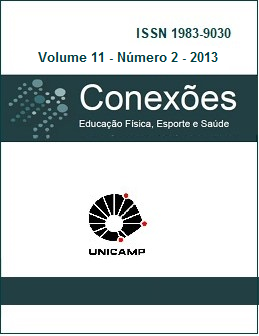Abstract
The objective of this study was to compare the physical fitness related to the performance of
40 Brazilian Army soldiers aged between 18 and 20 years, of which 20 were from special
operations platoon and the 20 conventional soldiers, military who exercise administrative
functions. The analysis of the difference in fitness of each group was possible by comparing
the results of two physical fitness test (TAF) performed at an interval of 12 weeks. The TAF
includes 12 minutes of running, push-ups, bending over and pull in the fixed bar. Prior to the
tests was measured the Body Mass Index (BMI) of each military. We performed a descriptive analysis of variables measured, giving data by using the mean and standard deviation. The
normality of data was evaluated by the Shapiro-Wilk test. We used the paired t-test and
Student's t test to verify the statistical inference between the mean between-group and
between groups, respectively. The values less than 5% (p ≤ 0.05) were considered
significant. The physical training performed by elite soldiers significantly (p ≤ 0.05)
difference from the other group in 60% of the evaluated variables. It was concluded that there
is a strong relationship between the performance of elite soldiers in the various tests of
physical evaluation and the way they conduct military physical training, targeted fashion,
respecting the level of intensity and volume and type of training provided for military
physical training manual.
References
BRASIL. Ministério da Defesa. Exército Brasileiro. Estado Maior do Exército. Manual de campanha: treinamento físico militar; C 20-20. Brasília , 2002.
OLIVEIRA, E. A. M. Validade do teste de aptidão física do exército brasileiro como instrumento para a determinação das valências necessárias ao militar. Revista de Educação Física, Rio de Janeiro, n. 131, p. 30-37, 2005.
MATIELLO-JÚNIOR, E.; GONÇALVES, A. Avaliando relações entre saúde coletiva e atividade física: Aspectos normativos e aplicados do treinamento físico militar brasileiro. Motriz, Rio Claro, v. 3, n. 2, dez.1997.
FLECK, S. J.; KRAEMER, W. J. Fundamentos do treinamento de força muscular. 3. ed. Porto Alegre: Artmed, 2006.
AMERICAN COLLEGE OF SPORTS MEDICINE (ACSM). Manual do ACMS para avaliação da aptidão física relacionada à saúde. Rio de Janeiro: Guanabara Koogan, 2006.
BOHME, M. T. S. Relações entre aptidão física, esporte e treinamento esportivo. Revista Brasileira de Ciência e Movimento, Brasília, v. 11, n. 3, p. 97-104, 2003.
POWERS, S. K.; HOWLEY, E. T. Fisiologia do exercício: teoria e aplicação ao condicionamento e ao desempenho. 5. ed. Barueri: Manole, 2005.
ROCHA, C. R. G. et al. Relação entre nível de atividade física e desempenho no teste de avaliação física de militares. Revista de Educação Física, Rio de Janeiro, v. 142, p. 19-27, set. 2008.
MARTINS, J. C. B. Avaliação e prescrição de atividade física: guia prático. 5. ed. Rio de Janeiro: Shape, 2003.
SAMPAIO, L. R.; FIGUEIREDO, V. O. C. Correlação entre índice de massa corporal e os indicadores antropométricos de distribuição de gordura corporal em adultos e idosos. Revista de Nutrição, Campinas, v. 18, n. 1, p. 53-61, 2005.
BRASIL. Ministério do Exército. Estado Maior do Exército. Portaria n. 32, de 31 de março de 2008. Aprova a Diretriz para o treinamento físico militar do Exército e sua avaliação. Brasília: EGGCF, 2008.
COOPER, K. H. A means of assessing maximal oxygen intake: correlation between field and treadmill testing. JAMA, Chicago, v. 203, n. 3, p. 201-204, 1968.
SHIGUNOV, V. Reflexões sobre os testes físicos em alunos universitários. Kinein, Florianópolis, v. 1, n. 1, set./dez. 2000. Disponível em: http://kinein.ufsc.br. Acesso em: 19 dez. 2011.
DIAS, A. C. et al. A relação entre o nível de condicionamento aeróbico, execução de uma pista de obstáculos e o rendimento em um teste de tiro. Revista Brasileira de Medicina do Esporte, São Paulo, v. 11, n. 6, p. 341-346, 2005.
KNAPIK, J. The Army Physical Fitness Test (APFT): a review of the literature. Military Medicine, v. 154, n. 6, n. 326-329, 1989.
BRASIL. Conselho Nacional de Saúde. Resolução no 196/96. Informe epidemiológico do SUS. Brasília: CNS, 1996. v. 2.
ORGANIZAÇÃO MUNDIAL DE SAÚDE (OMS). Obesity: controlling the global epidemic. Disponível em: http://www.who.int/nutrition/topics/obesity/en/. Acesso em: 14 fev. 2011.
HASKELL, W. L. et al. Physical activity and public health: updated recommendation for adults from the American College of Sports Medicine and the American Heart Association. Circulation, Baltimore, v. 116, p. 1081-1093, 2007.
CYRINO, E. S. et al. Efeito do treinamento de futsal sobre a composição corporal e o desempenho motor de jovens atletas. Revista Brasileira de Ciência e Movimento, Brasília. v. 10, n. 1, p. 41-46, 2002.
MCARDLE, W, D.; KATCH, F. I.; KATCH, V. L. Fisiologia do exercício: energia, nutrição e desempenho humano. 5. ed. Rio de Janeiro: Guanabara Koogan, 2003.
RODRIGUES, T. M. M. et al. Influência da corrida de 12 minutos na performance de flexão de braço no teste de avaliação física (TAF) em jovens militares. Revista de Educação Física, Rio de Janeiro, n. 131, p. 45-51, 2005.
GOMES, R. V. et al. Suplementação de carboidrato associada ao exercício de força não afeta o subseqüente desempenho no teste de potência aeróbica. Revista Brasileira de Ciência e Movimento, Brasília, v. 11, n. 4, p. 67-72, 2003.
MONTALVÃO, V. C. et al. Comparação do perfil antropométrico e funcional de escaladores militares e civis. Revista de Educação Física, Rio de Janeiro, v. 143, p. 28-34, 2008.
GLANER, M. F. Crescimento e aptidão física relacionada à saúde em adolescentes rurais e urbanos em relação a critérios de referência. Revista Brasileira de Educação Física e Esportes, São Paulo, v. 19, n. 1, p. 13-24, 2005.
The Conexões: Educação Física, Esporte e Saúde Journal uses the license of Creative Commons (CC), thus preserving the integrity of articles in an open access environment.


